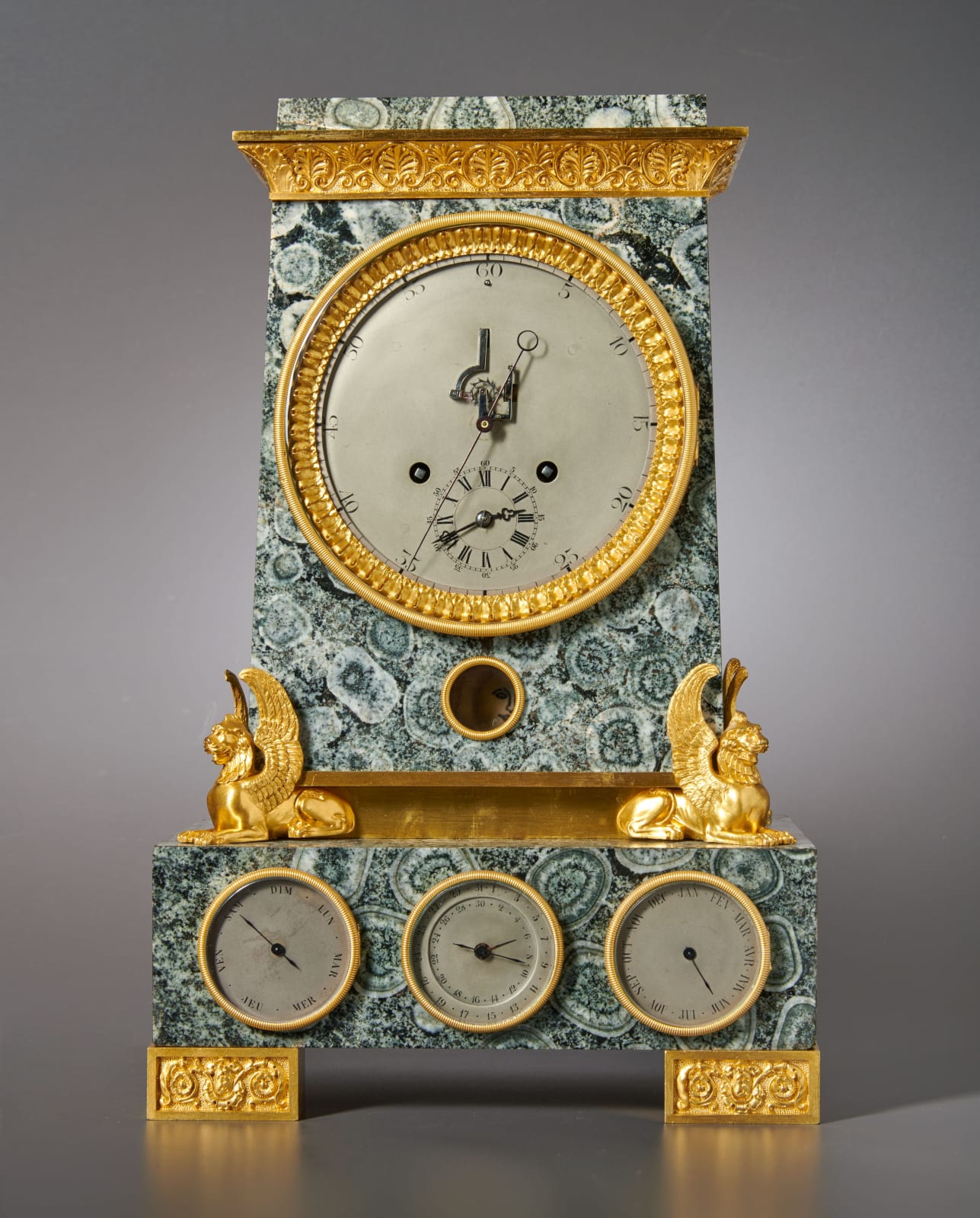Lépine (attributed to)
Literature
Derek Robert, “Precision Pendulum Clocks, France, Germany, America and Recent Advancements”, 2004, p. 70, pl. 29-, illustrating an extremely similar regulator by Lépine à Paris of circa 1840.
A rare Louis Philippe gilt bronze mounted orbicular granite astronomical table regulator with secular perpetual calendar attributed to Lépine à Paris. The matt silvered dial with a rare visible coup perdu escapement, outer Arabic second numerals and a blued steel sweep centre seconds pointer, with a small inset dial above 6 o’clock with an outer Arabic minute ring and inner Roman hour ring and a pair of blued steel trefoil hands for the hours and minutes. Below the dial on the plinth is a circular aperture to view the painted phases of the moon and on the base - three subsidiary dials, that on the left showing the days of the week, that at centre showing the days of the month with inner age of the moon, while the dial to the right showing the months of the year, each dial with blued steel pointers. The movement with going barrels on both trains, a rare coup perdu escapement with jewelled pallets exposed on the dial, half second beating pendulum with Brocot suspension, striking on the hours and half hours with outside count wheel. The orbicular granite case shaped as a rectangular plinth with slightly slanting sides, with a gilt bronze palmette and anthemion frieze above the dial. The granite plinth on a thin gilt bronze plinth supported at each corner by outward facing winged lions on an orbicular granite base supported on rectangular gilt bronze feet
Paris, date circa 1845
Height 40 cm, width 27 cm, depth 20 cm.
Like the very best French clocks, this highly unusual clock is not only a work of art but is a high quality precision instrument. Amongst other horological advancements, it has a perpetual calendar, which means that it automatically corrects the calendar according to the variation of days in the month and months in the year. The particular type used here is a perpetual and secular leap year calendar mechanism, which was invented by Bienaymé à Dieppe, who in 1842 filed its patent. Whilst the present clock is not signed it is remarkably similar to another signed on the silvered dial LEPINE A PARIS (illustrated in Derek Roberts, op. cit.). The overall design of the case is identical except for the fact that the simpler Lépine gilt bronze mounted clock case is of mahogany and lacks the winged lions. The arrangements of the dials are also almost identical though they vary slightly in detail and again the visible Lépine escapement is of a different type. Nevertheless the similarities are so close to suggest that the present example was most probably also made by Lépine à Paris. The firm of Lépine was renowned for precision clockmaking. By the time that this clock was made, the business was no longer owned by the Lépine family, though it continued under its original name. Derek Roberts notes that following the death of Pierre-Claude Raguet-Lépine (1753-1810), the business was inherited by his son Alexandre. Five years later he sold it to Paul Chapuy, from whom it was acquired by Calvet. By 1840 it was owned by Faure and in 1853 by Bouley. In addition to its horological ingenuity, this clock boasts a superb case made from orbicular granite. This was an unusual type of stone of unique appearance due to the concentrically layered spheroidal structures known as orbicules, which were probably formed through nucleation around a grain in a cooling magma chamber. It is likely that the present granite came from a quarry near Olmeto in Corsica which was discovered in 1785 and was mined from the beginning of the nineteenth century. The stone was also known as Napoleonite or Corsite after the island of Corsica.



